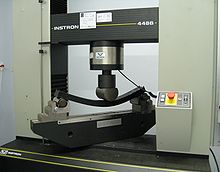Bending test
The bending test or bending tensile test is a method of destructive material testing .
There are different types of bending tests, the sequence of which is similar and which differ in the type of specimen storage and the number of load applications. Various material parameters and the stress-strain curve of the bending stress can be determined from the recorded bending force and deflection values.
procedure
Different testing devices are used depending on the type of flexure test. What they all have in common is that the load application (s) and the supports are arranged parallel to one another and are rounded (e.g. rollers).
If it cannot be guaranteed that the top and bottom of the test specimen are aligned plane-parallel to one another, the load introduction (s) and a support must be tilted in the plane perpendicular to the longitudinal axis of the test specimen; the test body then only has linear contact with the test device.
The test specimen is placed in the center of the test device and loaded with a slowly and steadily increasing force ( quasi-static ) until it breaks due to the load introduction (s ) . The maximum load is called the breaking force . If the deflection is small, the formula of the bending line gives an analytical approximation for the deformation of the test specimen.
2-point bending test
In the 2-point bending test, the test specimen is clamped at one end and loaded with a test stamp on the exposed side. The flexural modulus for a flat specimen is calculated as follows:
- E : flexural modulus in kN / mm²
- l v : span in mm
- X H : End of the bending modulus determination in kN
- X L : Start of the bending modulus determination in kN
- D L : Deflection in mm between X H and X L
- b : sample width in mm
- a : sample thickness in mm
3-point bending test
In the 3-point bending test, the test sample is positioned on two supports and loaded in the middle with a test stamp. This is probably the most common type of flexure test. The flexural modulus for a flat specimen is calculated as follows:
4-point bending test
In the 4-point bending test, the test sample is positioned on two supports and loaded in the middle with a test stamp with two pressure points. This leads to a constant bending moment between the two support points . This creates an area free of transverse forces in which the specimen is only subjected to bending stress. This has the advantage that there are no additional transverse forces acting as in the 3-point bending test.
The flexural modulus for a flat specimen is calculated as follows:
- l A : Span length (distance between the support point and the closer pressure point of the test stamp) in mm
- l B : Length of the reference bar (between the pressure points, bars placed symmetrically to the pressure points) in mm
- D L : Distance between the reference bar and the bar (in the middle between the pressure points) in mm.
Web links
Norms
- DIN EN ISO 7438: 2012 Metallic materials - Bending test
- DIN EN ISO 178 (2019-08) Plastics - Determination of the bending properties
- DIN EN ISO 14125 Fiber-reinforced plastics - Determination of flexural properties (ISO 14125: 1998 + Cor.1: 2001 + Amd.1: 2011); German version EN ISO 14125: 1998 + AC: 2002 + A1: 2011
- DIN EN 12390-5 (2009-07) Testing hardened concrete - Part 5: Flexural strength of test specimens; German version EN 12390-5: 2009
- DIN EN 843-1: 2006 High-performance ceramics - Mechanical properties of monolithic ceramics at room temperature - Part 1: Determination of flexural strength
- DIN EN 843-2: 2006 High-performance ceramics - Mechanical properties of monolithic ceramics at room temperature - Part 2: Determination of the modulus of elasticity, shear modulus and Poisson's number
- DIN 53452: 1977-04 bending test (withdrawn)
- DIN EN ISO 20795-1: 2013-06 Dentistry - Plastics - Part 1: Denture plastics
Individual evidence
- ↑ EN 12390-5: 2000: Testing hardened concrete Part 5: Flexural strength of test specimens German version.
- ↑ tec-science: bending test. In: tec-science. July 13, 2018, accessed on November 9, 2019 (German).





